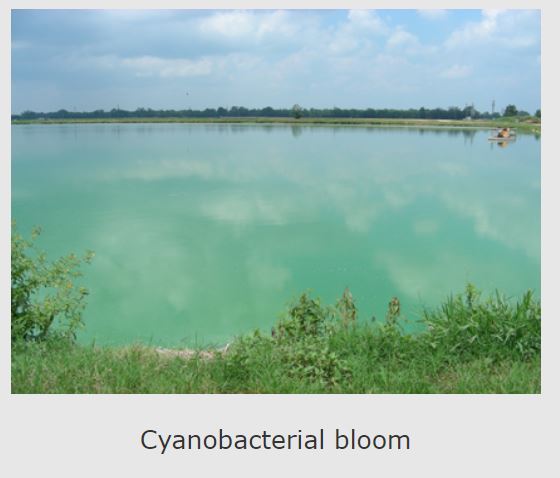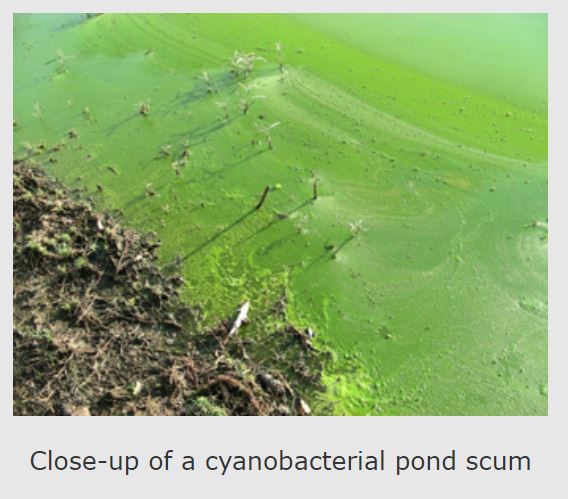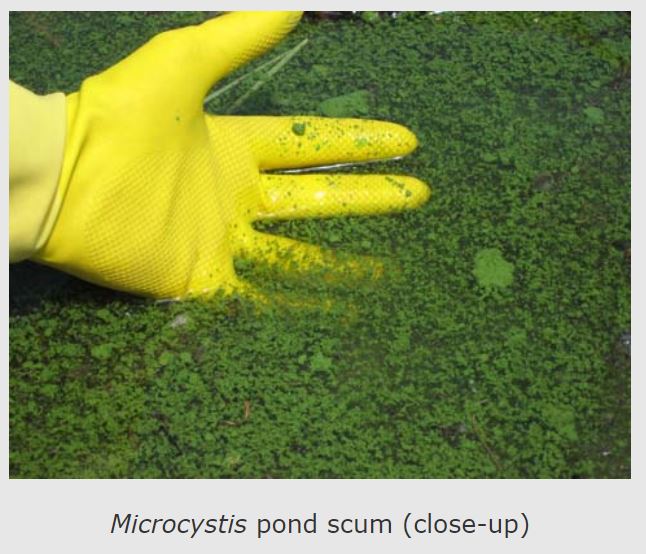UPDATE: Free stakeholder meeting during 10th US Harmful Algal Bloom (HAB) symposium on November 6th. (More info below)
Dr. Alan Wilson is a professor in Auburn University’s School of Fisheries, Aquaculture, and Aquatic Sciences in the College of Agriculture. Dr. Wilson has offered his thoughts on recent news stories of pet deaths related to poor water quality, specifically freshwater algal blooms.

What is blue-green algae and what makes it toxic?
Blue-green algae (more formally called cyanobacteria) are a large, morphologically and functionally diverse group of photosynthetic bacteria that are found everywhere on the planet, including lakes, oceans, deserts, and tundra. Blue-green algae are chemically rich and are capable of producing many chemicals, including compounds that make drinking water taste muddy (i.e., off-flavors) or toxins that can harm pets, aquatic organisms like fish, and other animals.
Not all blue-green algae produce toxins. Moreover, not all blue-green algae with the ability to produce toxins (i.e., have molecular machinery; also called toxigenic) [necessarily] produce toxins. Toxin production in blue-green algae can be caused by changes in environmental factors, such as temperature, available nutrients, salinity, or interactions with other organisms, or the life-cycle of the organism. For example, when blue-green algae die, they rupture, allowing their internal contents, including toxins, to enter surrounding water. Thus, to have a toxic blue-green algal bloom, it is necessary to have abundant toxigenic blue-green algae that are producing toxins.
Toxin exposure thresholds have been around for many years (for example, the World Health Organization’s Guidelines for safe recreational water environments and Toxic cyanobacteria in water), however the U.S. Environmental Protection Agency recently announced recreational exposure advisories for several blue-green algal toxins.

Source: http://wilsonlab.com/photos.html
What types of water bodies does it affect?
Blue-green algae are found in all kinds of ecosystems around the planet but tend to be most abundant – and problematic – in nutrient-rich, warm, freshwater lakes, reservoirs, rivers, and ponds.
Blue-green algal blooms along the coast are generally rare because of high salinity, however these events have recently been observed along the Gulf Coast due to an unusually heavy and long-lasting release of freshwater from the Mississippi River through the Bonnet Carré spillway in Louisiana. Although not blue-green algae, red tides are well-known toxic algal blooms of another group of phytoplankton (i.e., dinoflagellates) in coastal systems that can harm marine fish and mammals.
Like true plants, blue-green algae need a few things to thrive, including water, sunlight, carbon dioxide, and nutrients commonly found in garden fertilizer, such as phosphorus and nitrogen. Of these requirements, nutrient inputs and availability are likely the easiest to manage. With that said, managing blue-green algal blooms is not easy. Several great online resources exist to educate the educate the public about blue-green algal blooms, including from the U.S. EPA and Centers for Disease Control and Prevention (CDC).
My colleagues and I are organizing the biannual U.S. Symposium on Harmful Algae in beautiful Orange Beach, AL, on November 2-8, 2019, and it will be a great opportunity for everyone who is interested in algal blooms, including academics, industry professionals, teachers, legislatures, and the general public, to learn from U.S. experts. (For more information, visit the event website HERE)

Source: http://wilsonlab.com/photos.html
What precautions should people take for themselves and for their pets or livestock?
Generally, I discourage people to let their children, pets, or livestock get into green waterbodies, especially during warm summer months or when blue-green algal scum is present. We have plenty of beautiful, clear, and safe recreational waterbodies around the State to enjoy. There is no need to risk anyone’s health by recreating in water during a blue-green algal bloom. If you do find yourself or your pet in a blue-green algal bloom, rinse with tap water immediately and do not let your pet lick their fur where mats of alga material could concentrate toxins. Moreover, the US EPA recently released some advice about keeping pets safe during blue-green algal blooms.
Can you tell by looking at the water if it is safe?
Yes, with a bit of training, it is certainly possible to identify some blue-green algae from the pond bank. For example, the colonial blue-green alga, Microcystis, can form thick scums that are often times John Deere green in color. It is possible to see individual colonies of Microcystis with the naked eye since they can get fairly large (i.e., 1 mm). Other blue-green algae, like Aphanizomenon or Dolichospermum (name recently changed from Anabaena), can form scums, but their appearance from shore will look different (i.e., see some pictures of blue-green algal blooms HERE).

Some blue-green algae, like Cylindrospermopsis, don’t typically form scums even when abundant. There are other kinds of algae, including euglenoids, tiny plants, including duckweed, or even tree pollen that can form scums and look like blue-green algal blooms. So, not all green waterbodies are dominated by blue-green algae, but it is safe to bet to be wary of nutrient-rich, green ponds in Alabama in the summer.
I have led several workshops where I have trained academics, agency scientists, and aquaculture farmers how to identify blue-green algae and recently analyzed water samples for the general public, water utilities, state agencies, and zoos concerned about harmful algal blooms. If anyone is worried about their favorite waterbody, they can connect with me at http://wilsonlab.com/
What are the symptoms for people and animals?
Blue-green algae are chemically diverse, including many toxins and off-flavor compounds. The known toxins produced by blue-green algae, include hepatotoxins (e.g., microcystin), neurotoxins (e.g., anatoxin-a), or dermal toxins (e.g., lyngbyatoxin). Exposure routes include ingestion, inhalation, and direct contact. Since people and pets can vary in their sensitivity to blue-green algal toxins, symptoms of exposure to these compounds vary but can include diarrhea, vomiting, stumbling, loss of appetite, muscle twitching, rashes, allergic reactions, and even death in extreme cases. There are a variety of great online resources produced by U.S. EPA for pet owners or by the World Health Organization for recreational users.
More about the Expert:
Dr. Wilson has been studying algal blooms for the past two decades and is broadly interested in understanding the ecology of algal blooms in recreational, drinking, aquaculture, and zoo waterbodies. These diverse aquatic systems serve as Dr. Wilson’s teaching venues where he trains graduate and undergraduate researchers.
Soon after arriving at Auburn in 2007, Dr. Wilson developed a large-scale project with agency, academic, and industry collaborators throughout much of the Southeastern US to help develop models to forecast cyanobacterial blooms in this region. More recently, Dr. Wilson has been studying the factors responsible for off-flavor events in Alabama reservoirs that cause drinking water to smell and taste muddy.
Connect with the Expert
You can learn more about Dr. Wilson’s research at http://wilsonlab.com/ or directly connect with him at wilson@auburn.edu if you have water quality questions or concerns.
UPDATE (*text from event website)
The University of South Alabama, Dauphin Island Sea Lab, in partnership with Mississippi-Alabama Sea Grant Consortium, is hosting a free two-hour stakeholder discussion session at the upcoming 10th US HAB symposium being held at the Perdido Beach Resort in Orange Beach, Alabama on Wednesday, November 6th, from 4:00 to 6:00 pm in the Ballroom.
To learn more about the session and view a draft agenda, visit the US HAB symposium website at: ushabs.com
Register at https://www.eventbrite.com/e/ushab-stakeholders-scientists-community-meeting-roundtable-tickets-74710185175
Contact Melissa Partyka, mlp0069@auburn.edu or Alison Robertson, arobertson@disl.org about this stakeholder session or with any other questions related to HABs
